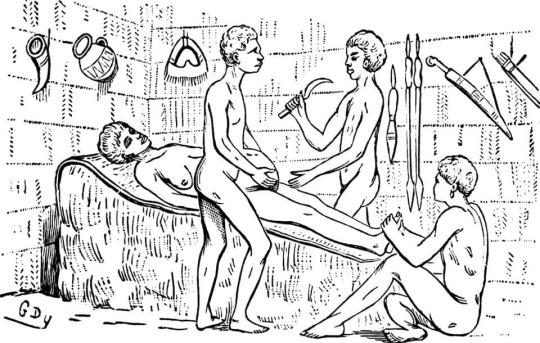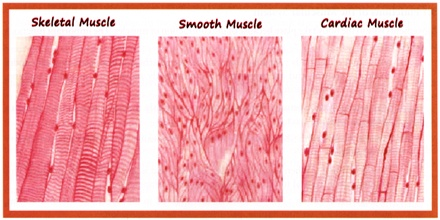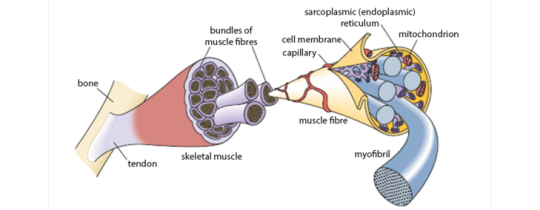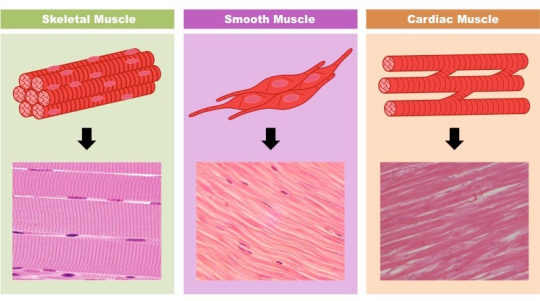Text

Did you know that modern C sections were invented by African women— centuries before they were standard elsewhere?
Midwives and surgeons living around Lake Tanganyika and Lake Victoria perfected the procedure hundreds of years ago. When a baby couldn’t be delivered vaginally, these healers sedated the laboring mother using large amounts of banana wine. They tied the mother to the bed for safety, sterilized a knife using heat, and made the incision, acting quickly as a team to prevent excessive blood loss or the accidental cutting of other organs. The combination of sterile, sharp equipment and sedation made the procedure surprisingly calm and comfortable for the mother.
After the baby was delivered, antiseptic tinctures and salves were used to clean the area and stitches were applied. Women rarely developed infections, shock, or excessive blood loss after a cesarean section and the most common problem reported was that it took longer for the mother’s milk to come in (an issue that was solved with friends and relatives who would nurse the baby instead).
In Uganda, C sections were normally performed by a team of male healers, but in Tanzania and DRC, they were typically done by female midwives.
The majority of women and babies survived this, and when questioned about it by European colonists in the mid-1800s, many people in Uganda and Tanzania indicated that the procedure had been performed routinely since time immemorial.
This was at a time when Europeans had only barely started to figure out that they should wash their hands before performing surgery, when nearly half of European and US women died in childbirth, and when nearly 100% of European women died if a C section was performed.
Detailed explanations of Ugandan C-sections were published globally in scholarly journals by the 1880s and helped the rest of the world learn how to save mothers and babies with minimal complications.
So if you’re one of the people who wouldn’t be alive today without a C-section, you have Ugandan surgeons and Tanzanian and Congolese midwives to thank for their contributions to medical science.
115K notes
·
View notes
Text
Muscle tissue
Muscle tissue is made from a collection of highly specialised muscle fibres, formed by the fusion of individual muscle cells (myocytes).
All muscles are contractile and excitable and contain the proteins myosin and actin, which are responsible for contraction.

Skeletal muscles
Voluntary muscles
Attached to bones via tendons
Muscle tissue is surrounded by supporting and protecting bands of fibrous connective tissue called fascia
Plentiful nerve and blood supplies which an active muscle requires are located within fascia.
The muscle cells fuse into fibres and contain the contractile proteins actin and myosin, arranged in myofibrils, giving skeletal muscle its histological, striated appearance.
Within a myofibril, actin and myosin are interleaved, producing the characteristic striated (striped) appearance, which can be seen under the microscope and is shown schematically in the figure below. When a muscle contracts the actin and myosin slide across each other, causing the striations to bunch up.
Energy is required to relax the muscle
The default condition is contraction
When a muscle runs out of energy it contracts, as occurs in cramp and rigor mortis.

Overlapping proteins actin and myosin produce the characteristic pattern of striations in skeletal muscle.
Smooth and Cardiac Muscle
In contrast to skeletal muscle, both cardiac and smooth muscle are involuntary muscles, meaning that we cannot voluntarily control their contraction.
In cardiac muscle the myocytes form a network, with crosslinks and intercalated discs between the cells. They have striations comparable to those in skeletal muscle.

Smooth muscle is found in the wall of blood vessels and many hollow organs, including the uterus, the bladder and along all parts of the gastrointestinal tract.
Divided into two subgroups; the single-unit (unitary) and multiunit smooth muscle.
Within single-unit cells, the whole bundle or sheet contracts as a syncytium.
Smooth muscle cells are also present in the eyes and are able to change the size of the iris and alter the shape of the lens.
In the skin, smooth muscle cells cause hair to stand erect in response to cold temperature or fear.
2K notes
·
View notes
Text
Before I start this little spiel, I need you all to know: I’m not hating on people who don’t vaccinate their kids, and while I know for a fact BASED ON facts that vaccines don’t cause autism or other “defects”, I’m all for continuing research to make them even better and safer.
But you know what really, really scares me about the anti-vax movement? As a future Public Health Professional, the thing that scares me most about this is the fact that our cultural mindset has become so CHILL about vaccine-preventable/”childhood” diseases that there is even room for such a movement. Let me explain.
Do y’all know what an R0 is? The R-naught, as it is called, is the basic reproduction rate of a disease. It tells you how many new infections can come from one existing infection. For example, an R-naught of 3 (R3) means that, on average, one sick person will infect three other people. Every disease has an R-naught, some greater and some lesser.
Do you remember when everyone was freaking out about Ebola? Everyone was terrified of catching it, because it’s SOOOOO contagious and deadly, right? Ebola has an R-naught of 2. That’s it. R2. One person with Ebola, on average, will get 2 more people sick. And we were freaking out about that.
Well guess what? Measles is the most contagious disease known to mankind, and it has an R-naught of 18. 18. One person with measles will give it to 18 new people, and those people will give it to 18 new people EACH, and so on. That’s what happened with the Disneyland outbreak; it’s so ridiculously contagious that just ONE sick child was enough to start an epidemic.
And yet very few people are as scared of measles as they are of Ebola. Why is that? One reason could be the nature of the disease, sure; Ebola is terrifying in its progression and symptoms. But I would suggest that a major reason is that measles has been so well-contained by vaccination that people no longer fear it. It’s not a part of every-day life anymore; this disease is no big deal because nobody gets it, because so many people are vaccinated against it. Let’s put this another way.
What are the diseases that scare everyone the most: Ebola, HIV/AIDS, and SARS are pretty high on the list of terror diseases. But let’s look at the R0s, shall we: Ebola-R2. HIV/AIDS-R5. SARS-R5.
Now let’s look at diseases that people are voluntarily rejecting vaccinations against: Measles, Pertussis, and Diphtheria are the major ones. Their R0s? Measles-R18. Pertussis-R17. Diptheria-R7.
Everyone focuses on the former set of diseases– rightly so, I suppose– because they’re more dangerous at the present time. What makes them more dangerous? Not their R0; it’s the fact that there is no viable treatment, and NO VACCINE. Seriously, that’s why the medical community is worried about them. There’s no way to treat or PREVENT their spread biologically. Well guess what? There’s no viable treatment for Measles or Pertussis, and only limited treatment options for Diphtheria. That’s why the medical community doesn’t focus on them as much, because we can prevent them at the biological level, safely and effectively.
But now that the Anti-Vax movement has taken hold so firmly, the medical community is now being forced to once more worry about diseases it had almost eradicated. And not only that, it’s endangering herd immunity for the people who can’t receive their own vaccines due to compromised immune systems. I’m allergic to eggs, so I can’t receive the flu shot, but I’m also asthmatic so I can’t get the inhaled vaccine. I rely entirely on the people I associate with to keep me safe from the flu by getting their yearly shot. This made public school a living nightmare, because almost NOBODY got their shot. They caught it, and while it didn’t affect them TOO terribly because they were generally healthy, when I caught it, it was very dangerous because of my asthma. And then there’s that time when I caught the flu, and then right after because of my weakened immune system, I caught Whooping Cough from someone who hadn’t been vaccinated. I HAD been vaccinated, but my body was so fatigued from the flu that it couldn’t keep up with immune demands. And so I caught it.
Have you ever had Pertussis (whooping cough)? It’s hard enough on someone with full lung capacity; it can break ribs, it makes you cough so hard. You cough until there is literally no air in your lungs, and you have to inhale so forcefully it makes the “whooping” sound that gives it the name. It’s painful beyond belief, and it can last for weeks. Some people will survive it. But add that to asthma, or to a young child, or to an elderly person, and you are looking at either permanent damage or death, no exceptions. When I had it, I was about 6 years old, and asthmatic; I spent 81 hours awake because the coughing was so violent I physically couldn’t sleep. I tore abdominal muscles. I vomited during coughing fits and aspirated the vomit. I was actively dying. The doctors could barely suppress the cough enough for me to breathe at all. My inhaler wasn’t helping, none of the cough syrups or breathing treatments were helping; I was getting pneumonia on top of the virus. It was Hell. I was LUCKY that I didn’t die.
Who would wish that on their child? Nobody, I hope. And if you KNEW you could keep your child from ever experiencing that, wouldn’t you do whatever it took to ensure their safety?
Or would you look at the safeguard and say, “Nah. I’ll take my chances with my child’s life.”?
That is what the anti-vax movement is doing. Perhaps not purposefully, but that’s the end result. These aren’t just names on syringes designed to make a child cry; the diseases are real, and real threats to health and life, and the vaccines are how you prevent them. Yet we are so far removed from the impact and effects of these diseases BECAUSE of the peace brought to us BY vaccines that people now feel no qualm about refusing vaccines.
That’s what scares me about the anti-vax movement; people have become so complacent that they no longer worry about these very real, very deadly diseases. They’d rather risk their child’s life than get a shot? The side effects of vaccines are unproven (nonexistent), but the efficacy of vaccines are very much proven.
When the pertussis vaccine first came out, people jumped on it right away. They were so grateful to have it, and for a while everything was smooth sailing, and whooping cough was on the decline. Then, in the 70s, some groups started claiming the pertussis vaccine was causing brain injury in young children. Less than 50 in 15 million cases were reported, but it was enough to scare people away from the vaccine. And children began dying again. It was later discovered that it was NOT the vaccine, but the result of infantile epilepsy, that caused the brain damage. People began once more vaccinating their children, but not before hundreds if not thousands had died.
And that’s what’s happening now. A falsified claim scared just enough people that time-tested, lab-tested, fully-proven, totally safe vaccines are being rejected, and we’re already starting to pay with lives. And I’m scared it’s going to get worse. People don’t really grasp the full import of these diseases and the necessity of the vaccines until they have experienced the disease. I’m scared that it’s going to come down to new epidemics before people will realize the mistake of not vaccinating.
Right now we’re still in the semi-safe zone. Enough of the population is immunized that we could probably keep most pandemics of these diseases at bay. But if this movement keeps gaining momentum, there might come a day when measles and pertussis could once again destroy thousands of people yearly. Imagine if some terrorist group weaponized Ebola and used it against this country; so many people would die, because we have no vaccine for it, no way to prevent it. That is what could happen with diseases like mumps, rubella, measles, pertussis, Diphtheria, and polio. Except it wouldn’t be terrorists using a disease as a weapon; it would be some kid in your child’s class, or your neighbor across the street, or the guy who delivers the mail to your office. That’s how life used to be, and if someone from the pre-vaccine era could see us now, they’d weep for joy at the idea that we can prevent these horrific diseases; and then they’d weep in sorrow at the idea that people are voluntarily turning down that safeguard.
It’s true, vaccines aren’t always 100% effective; I was immunized, but still got Whooping Cough (lowered immune function, if you recall). But you know who didn’t get it? My baby sister. My big sister. My cousins. My mother and father. My classmates, the other kids at my doctor’s office. The nurses at the hospital. The pharmacy workers. Their children. The kids my mom taught at school. All those people were safe because of vaccines. And you know what else? When I was in India, I was exposed to polio. Didn’t get it. Know why? I was vaccinated. I was exposed to chicken pox in 5th grade. One unvaccinated kid got it, and the other 4 kids in our class who weren’t vaccinated got it. But you know who didn’t? The rest of us who WERE vaccinated.
Vaccination may not be perfect, and the only way we will improve them is by continuing research. But the fact remains that as they are now, vaccines cause no lasting side effects (injection site pain goes away), and are extremely effective at preventing dangerous, painful, debilitating, often deadly diseases. Let’s keep researching, yes, but in the mean time, PLEASE vaccinate. It’s not worth your life, or your child’s, or anyone else’s. Vaccines save lives, not destroy them.
45K notes
·
View notes
Text

Getting cellular metabolism down!
#studyblr#cellular metabolism#glycolysis#gluconeogenesis#krebs cycle#electron transport chain#physiology
2 notes
·
View notes
Text

Guess why got a rad human anatomy coloring book?
2 notes
·
View notes
Text
Molecule of the Day - Adrenaline/Epinephrine


Adrenaline (C9H13NO3), also known as epinephrine, is a naturally-occurring hormone and neurotransmitter found in our body. Along with noradrenaline, it is produced by the adrenal medulla, which is situated above the kidneys.

As a hormone, adrenaline stimulates the sympathetic nervous system, and is partly responsible for the “fight-or-flight” response.
It binds to adrenergic receptors, which are found in almost all tissues, inducing the breakdown of glycogen into glucose (see below), glycolysis, and also inhibits glycogen synthesis as well as insulin secretion. This results in a surge in glucose availability, providing a burst of energy needed to escape any danger.

Adrenaline also promotes vasoconstriction, the narrowing of blood vessels, as well as an increase in heart rate to raise the amount of blood being pumped throughout the body. This causes more oxygenated blood to reach the body at a faster rate, enabling cells to carry out respiration to produce more energy as well.

An interesting study revealed that adrenaline is associated with fear. A 1999 study showed that subjects injected with adrenaline experienced greater feelings of fear upon watching horror films. They also expressed greater negative emotions than the control group.
In nature, adrenaline is biosynthesised from phenylalanine through multiple enzyme-catalysed reactions:

On the other hand, adrenaline can be synthesised from resorcinol and 2-chloroethanoyl chloride in the lab:

983 notes
·
View notes
Text

Notes on glycolysis!
4 notes
·
View notes
Text

I had to get a CT scan, and I think my insides are pretty rad.
1 note
·
View note
Text
me: immune system why do i have a fever
immune system: well the bacteria can’t survive outside 37 degrees for long so i thought i’d raise the temperature to kill them off!
me:
immune system:
me:
immune system:
me: we also can’t survive outside 37 degrees for long
immune system:

315K notes
·
View notes
